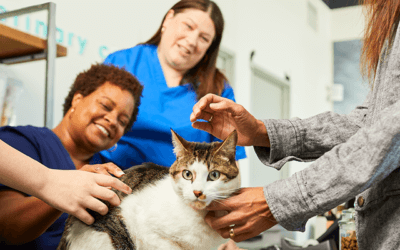The pet industry is booming in the United States and pet owners are spending more than ever. This translates into an amazing opportunity for veterinary practitioners looking to scale up their existing practice. Upscaling the customer experience with technologies like telemedicine and new digital marketing strategies is crucial for getting that influx of new clients to bond with your veterinary practice.
If you are looking to streamline appointment bookings for your veterinary practice, it is critical that you understand the fundamentals of marketing and look into new and exciting ways to promote your practice. We’re delving into how marketing and technology can help you unlock your full potential and create loyal fans out of new clients.
4 ways to deliver an exceptional experience for new veterinary clients
1. Integrate technology to streamline the customer experience
A good customer experience is instrumental in spreading positive word of mouth, bringing in new clientele, and retaining them. Leveraging technology can go a long way in streamlining the customer experience for existing as well as new patients.
Here are some of the most useful tech solutions that veterinarians should look to implement in their practice:
- Mobile apps — Telemedicine applications and mobile apps can increase your clients’ sense of involvement. This is especially true because they can easily reach out to you for assistance at any time by sending you videos, photos, or text messages describing the affected area on their pet’s body or newly acquired symptoms. Developing a mobile app for your practice can give you complete freedom in terms of the features that you want to include. For example, you can choose to send important updates to pet parents via push notifications. You can also use this feature to remind them of an upcoming appointment or medication that you’ve prescribed.
- Remote Patient Monitoring (RPM) and wearables — When combined with a telemedicine platform, these solutions can provide a continuous source of objective insights into the pet’s condition, which can be extremely beneficial if the pet suffers from a chronic disease. These insights can greatly assist veterinarians in improving outcomes while developing strong relationships with their clients.
2. Leverage digital marketing strategies
Social networking sites like Facebook, Twitter, and Instagram, make a great addition to engage with your clients. With 2.3 billion active social media users, there’s a strong chance the people you want to contact are already on social media.
Developing a clear understanding of your target audience may be the most important thing you do. All aspects of your marketing strategy are influenced by your target audience. Once you’ve identified your target market, you can figure out the strategy you’ll need to pursue to raise your practice recognition.
For example, if your target audience comprises Gen-Z and Millennials, memes can be used for engaging with your audience on your practice’s Facebook page. However, if the older generation forms a huge chunk of your target segment, the tone and style of your social media marketing will need to be more refined.
Marketing must always be targeted and assembled according to customer preferences. Targeted ads on social media websites can be a good place to start when building your online presence and expanding your reach to new customers while bonding with existing customers.
Reviews on websites such as Google and Facebook are other important customer magnets that you should be prioritizing within your marketing strategy.
3. Prioritize great customer service
Customer experience is key in the digital era. It’s all too easy to get caught up in care for pet patients and forget about the human clients. Since pet owners are the ones who foot the tab for their pets, it’s critical to keep their needs in mind.
It is important to take advantage of the digital environment in order to introduce new technologies for clients. However, if you intend to employ these technologies, you need to ensure that they function effectively and deliver value to your clients.
According to studies, digital demand will only grow—millennials are 39 percent more likely than the previous baby boomer generation to own a dog or cat in the future. Additionally, 40 percent of this population considers telemedicine to be an “extremely significant or very important option.” With these figures, there’s a compelling case to be made for starting those digital client engagements now, so they’re ready for the tech-savvy Generation Z.
Make sure that you are available after office hours in case of any emergency. Leverage veterinary telemedicine to widen your accessibility. Draw insights from the data buried in your practice management system and use it to furnish exceptional customer service. It’s not only good business, but it’s also fantastic marketing to provide exceptional and efficient service to both pet patients and pet owners.
4. Team up with other veterinary professionals
Consider teaming up with other businesses or professionals. Locate other pet care professionals and service providers in your region. By leveraging each other’s customers, you may both expand your current audiences and offer added value to your new clients.
For example, a pet supply company may advertise your veterinary services on their website in exchange for you placing an ad for their product, such as dog food. You can take it a step further by providing a coupon or special discount to each other’s consumers, posting flyers at each other’s offices/stores, or even forming a pet collaborative.
When a group of pet care providers and veterinary services band together and cross-promote each other, this can happen. A veterinarian, a pet food store, a pet groomer, and a dog walking service, for example, may form a full-service dog membership. A customer can pay a set monthly fee and have the collective provide all of the services he or she requires.
Start sending out marketing collaboration requests to industries with a pet care crossroads and see what happens.
Bond new clients to your veterinary practice
Every practice is distinct and different. As a result, what works well for one may not work well for another. The strategies discussed in this article are among the few that have uniformly demonstrated their potential and produced timely results for many.
As a veterinary practitioner, you always need to be on the lookout for new methods to integrate cutting-edge technology into the client experience, while simultaneously focusing on your own growth and expansion.



